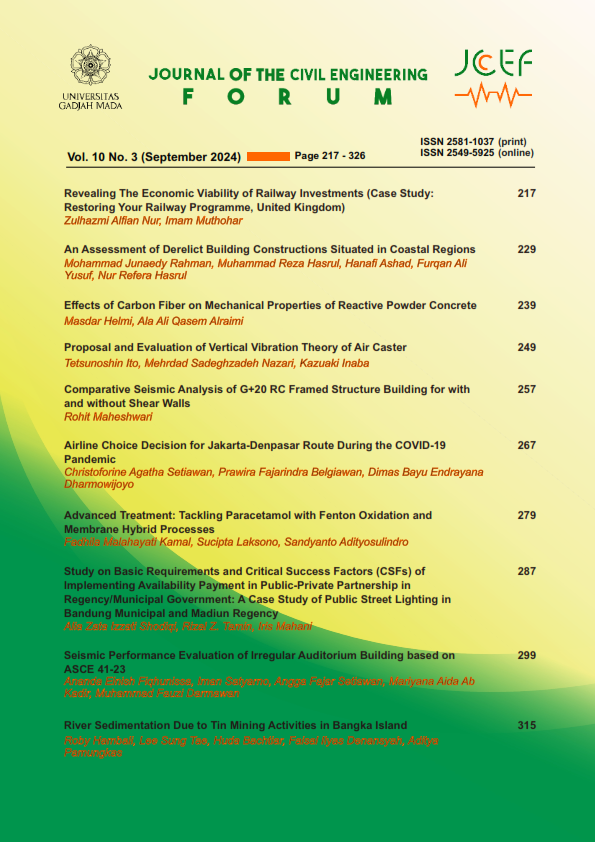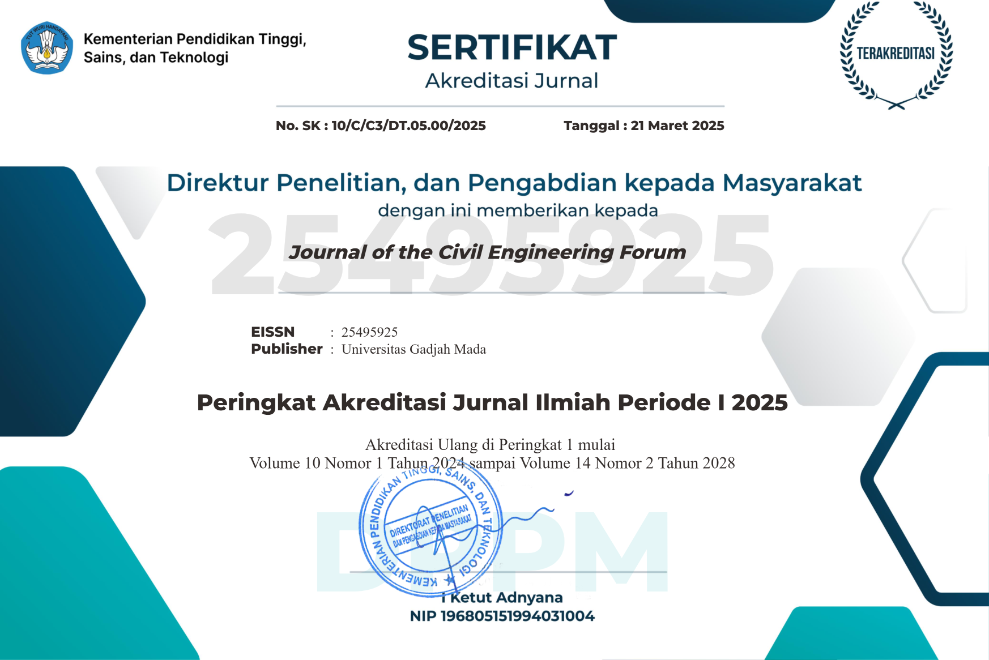Revealing The Economic Viability of Railway Investments (Case Study: Restoring Your Railway Programme, United Kingdom)
Abstract
The UK’s ”Restoring Your Railway” (RYR) programme aims to reopen abandoned railway infrastructure to foster local economic growth. However, since 2020, only 30% of RYR proposals have progressed, revealing challenges in the methodological approach, especially for projects introducing rail as a new mode. The current unimodal approach for estimating user benefits in such projects is considered inadequate. To address this, a Cost-Benefit Analysis (CBA) with improved methods for user benefit estimation has been conducted, compared with existing cases to determine if it results in a better Benefit-Cost Ratio (BCR). Historically, early appraisal methods relied on the Strategic Outline Business Case (SOBC), which took six months and incurred costs of approximately Rp. 1.5 billion. To expedite project delivery, sensitivity analysis explores circumstances under which RYR projects are socially justifiable across different Value for Money scenarios. Additionally, a comparative analysis is performed between the UK and Indonesian approaches. This study introduces a new CBA approach, focusing on user benefit estimation and conducting sensitivity analysis on key determinants. The mathematical CBA model, modified for the value of time and diversion factor, forms the basis for sensitivity analysis on BCR, travel time savings, capital and operational costs, diversion factor, and GDP growth. Testing the model against business cases reveals a 17-20% reduction in the required demand for the same BCR compared to conventional CBA approaches, suggesting the new method captures additional benefits related to mode shifts. Sensitivity analysis highlights circumstances under which railway projects are likely to deliver acceptable value for money, considering various BCR values. Total order indices show that operational costs contribute 40% to the model output, followed by capital costs and GDP growth rate at 29% and 25%, respectively. Surprisingly, the In-Vehicle Time (IVT) for trains has only a small contribution, ranging from 1.83% to 4%.
References
AECOM (2019), The Northumberland Line Strategic Outline Business Case, Northumberland County Council.
Beesley, M. E. (1965), ‘The value of time spent in travelling: Some new evidence’, Economica 32(126), 174. URL: https://doi.org/10.2307/2552547
Boldeanu, F. T. and Constantinescu, L. (2015), ‘The main determinants affecting economic growth’, Bulletin of the Transilvania University of Braşov Series V: Economic Sciences 8(57), 229–338.
Cairns, T. (2023), ‘Realtime trains’. URL: https://www.realtimetrains.co.uk
De Rus, G. (2010), Introduction to Cost–Benefit Analysis: Looking for Reasonable Shortcuts, Edward Elgar Publishing Limited, Cheltenham, Gloucestershire, UNITED KINGDOM. URL: http://ebookcentral.proquest.com/lib/leeds/detail.action?docID=599691
de Rus, G. and Nash, C. (2007), In what circumstances is investment in high speed rail worthwhile?, Working paper, Institute of Transport Studies, Leeds, UK. Department for Transport (2016), ‘Free flow vehicle speeds great britain: 2015’.
Department for Transport (2017), ‘Rail factsheet: 2017 - gov.uk’, GOV.UK.
Department for Transport (2020), ‘Restoring your railway fund - gov.uk’, GOV.UK.
Department for Transport (2022a), TAG Unit A1.3 User and Provier Impacts, London, United Kingdom.
Department for Transport (2022b), Transport analysis guidance, London.
Department for Transport (2023a), Tag Databook 31 May 2023, London.
Department for Transport (2023b),TAG Unit A1.1: Cost-Benefit.
Dunkerley, F., Wardman, M., Rohr, C. and Fearnley, N. (2018), ‘Bus fare and journey time elasticities and diversion factors for all modes: A rapid evidence assessment’. URL: https://doi.org/10.7249/rr2367.
Foster, C. D. and Beesley, M. E. (1963), ‘Estimating the social benefit of constructing an underground railway
in london’, Journal of the Royal Statistical Society. Series A (General) 126(1), 46–93.
Hadley, D. (2011), Sensitivity Analysis Within Cost Benefit Analysis, SPICOSA.
Hampshire Council (2021), ‘Waterside rail re-opening strategic outline business case’.
Harberger, A. C. (1962), ‘Cost-benefit analysis and economic growth’, The Economic Weekly.
Hensher, D. A. (2001), ‘Measurement of the valuation of travel time savings’, Journal of Transport Economics and Policy 35(1), 71–98.
HM Treasury (2022), ‘The greenbook: Central government guidance on appraisal’.
House of Lords (2011), ‘Reversing the beeching closures: Full steam ahead?’. URL: https://researchbriefings.files.parliament.uk/documents/LLN-2020-0052/LLN-2020-0052.pdf
Lancashire County Council (2021), ‘Fleetwood railway line reopening feasibility study’.
Lancefield, N., Rahman, G. and Jones, I. (2017), ‘Britain’s trains four times slower outside south east’. URL: https://www.independent.co.uk/news/uk/homenews/uk-trains-four-times-slower-south-east-london-national-rail-network-speeds-journeys-a7916791.html
Mackie, P. J., Wardman, M., Fowkes, A., Whelan, G., Nellthorp, J. and Bates, J. (2003), ‘Value of travel time savings’, Transportation Research Record: Journal of the Transportation Research 2470(1), 161–168. URL: https://doi.org/10.3141/2470-17
Nash, C. (2015), ‘When to invest in high speed rail’, Journal of Rail Transport Planning Management 5(1), 12–22. URL: http://dx.doi.org/10.1016/j.jrtpm.2015.02.001
Nash, C. and de Rus, G. (2010), ‘In what circumstances is investment in high speed rail worthwhile?’, Online. URL: http://eprints.whiterose.ac.uk/2559/
Nellthorp, J. (2017), The principles behind transport appraisal, in‘The Routledge handbook of transport economics’, Routledge, pp. 176–208.
Network Rail (2020), ‘Rail speed’. URL: https://www.networkrail.co.uk/industry-andcommercial/supply-chain/existing-suppliers/rail-speed/
Northern Railway (2023), ‘How fast do northern trains go?’. URL: https://www.northernrailway.co.uk
Office for National Statistic (2023), ‘Gross domestic product: chained volume measures: Seasonally adjusted £m. data and analysis from census 2021’.
Office of Rail and Road (2022), ‘Franchised passenger train operator finances since april 2015’.
Office of Rail and Road (2023),‘Passenger kilometres by operator, great britain, 2011 - 2023’.
Ojeda-cabral, M., Batley, R. and Johnson, D. (2021), ‘Rail openings appraisal review and development of appraisal practice for new railway lines’.
Quah, E., Tan, T. S. and Lee, Z. J. L. (2021), Cost-benefit analysis in developing countries, 1st edn, Elsevier Inc. URL: https://doi.org/10.1016/bs.atpp.2021.02.002
Queensland Government (2011), Cost-benefit Analysis manual, first edn, Queensland: Transport and Main Roads.
Rayment, M., Knight, T., Lloyd, R., Purdon, S. and Bryson, C. (2021), Group work / jobs ii: Cost benefit analysis technical report, Technical report.
Reuillon, R., Leclaire, M. and Rey-Coyrehourcq, S. (2013), ‘Openmole, a workflow engine specifically tailored for the distributed exploration of simulation models’, Future Generation Computer Systems 29(8), 1981–1990. URL: https://doi.org/10.1016/j.future.2013.05.003
Saltelli, A. (2002), ‘Sensitivity analysis for importance assessment’, Risk Analysis 22(3), 579–590. URL: https://doi.org/10.1111/0272-4332.00040
Saltelli, A., Annoni, P., Azzini, I., Campolongo, F., Ratto, M. and Tarantola, S. (2010),‘Variance based sensitivity analysis of model output. design and estimator for the total sensitivity index’, Computer Physics Communications 181(2), 259–270. URL: https://doi.org/10.1016/j.cpc.2009.09.018
Saltelli, A., Ratto, M., Andres, T., Campolongo, F., Cariboni, J., Gatelli, D., Saisana, M. and Tarantola, S. (2008), Global sensitivity analysis: the primer, John Wiley Sons.
Sheffield City CA (2021), ‘Barrow hill line reopening – strategic outline business case’.
Stubbs, P. C., Tyson,W. J. and Dalvi, M. Q. (2017),Transport economics, Routledge.
TfN (2019), At a glance: Northern Powerhouse Rail, TRANSPORT.
Tra (2012), Borders Railway Final Business Case final version.
Tyers, R. and Dallas, M. (2023), Restoring your railway fund, Technical report.
Weisbach, D. A., Hemel, D. J. and Nou, J. (2018), ‘The marginal revenue rule in cost-benefit analysis’, Tax Notes 160(11), 1507–1528. URL: https://ssrn.com/abstract=3254325
West of England Combined Authority (2014), Metrowest phase 1: Preliminary business case report, Technical report, Bristol.
Winkler, C. (2015), ‘Transport user benefits calculation with the ’rule of a half’ for travel demand models with constraints’, Research in Transportation Economics 49, 36–42. URL: https://doi.org/10.1016/j.retrec.2015.04.004
Copyright (c) 2024 The Author(s)

This work is licensed under a Creative Commons Attribution-ShareAlike 4.0 International License.
Copyright is granted to authors for the purpose of providing protection for articles written to describe experiments and their results. JCEF will protect and defend the work and reputation of the author and are also willing to address any allegations of violation, plagiarism, fraud, etc. against articles written and published by JCEF. JCEF is published under the terms of the Creative Commons Attribution-ShareAlike 4.0 International License (CC BY-SA 4.0). The author holds the copyright and assigns the journal rights to the first publication (online and print) of the work simultaneously.







